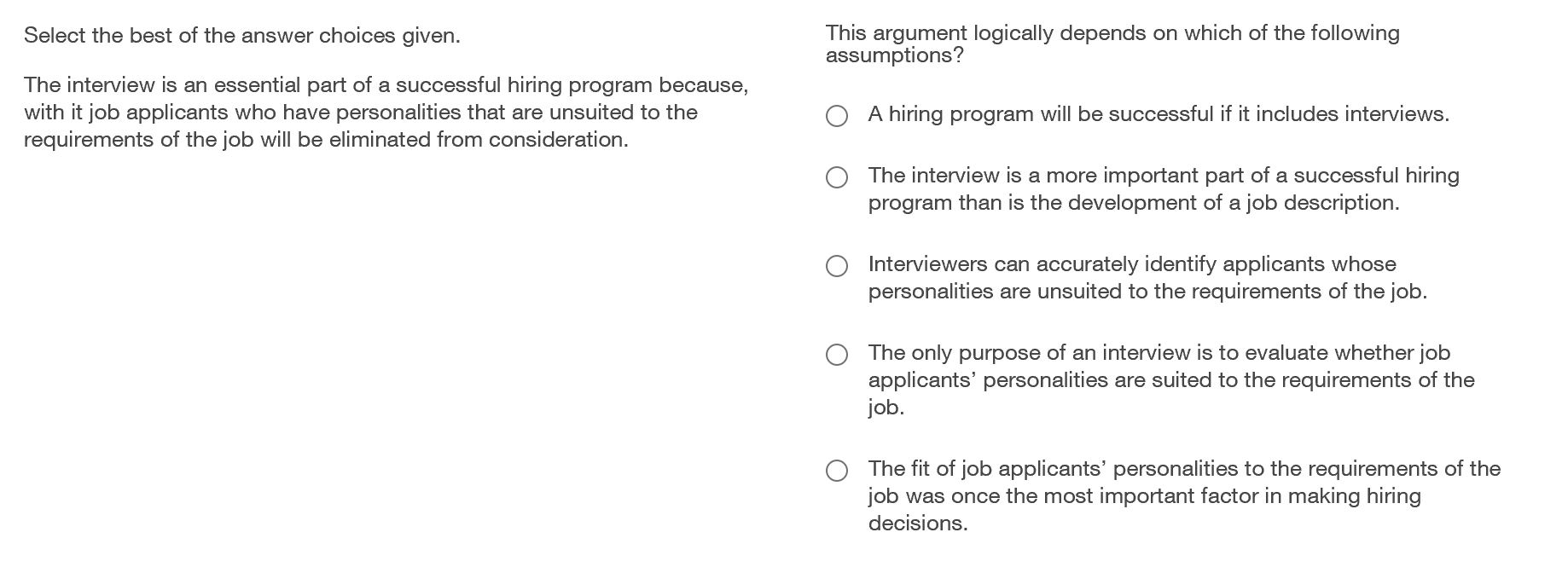
Critical reasoning questions often worry GMAT test-takers. What exactly are GMAT critical reasoning questions, and what skills do you need to develop to answer them correctly? How can you best prepare for critical reasoning questions before the exam?
In this article, I’ll go over the five main critical reasoning question types and examples of each one, as well as plenty of GMAT critical reasoning tips on how to ace these question types come exam day.
GMAT Critical Reasoning Overview
Critical reasoning questions appear in the verbal section of the GMAT, alongside sentence correction questions and reading comprehension questions. There are 36 questions in total on the verbal section, and around 11 of them are critical reasoning questions.
GMAT critical reasoning questions test your ability to evaluate and draw conclusions based on logical arguments. You won’t need any formal training in logic or rhetoric to do well on critical reasoning questions. However, you will need to be able to analyze an argument and unpack it into its various parts.
The 5 GMAT Critical Reasoning Question Types
There are five main critical reasoning question types: Strengthen the Argument, Weaken the Argument/Find the Flaw, Inference, Draw a Conclusion, Find the Assumption, and Paradox/Discrepancy. Let’s go through each question type. For each question type, we’ll go over what the question will be asking you to do, key words associated with that type, how each it will be worded, and an example question.
Not sure how or what to study? Confused by how to improve your score in the shortest time possible? We've created the only Online GMAT Prep Program that identifies your strengths and weaknesses, customizes a study plan, coaches you through lessons and quizzes, and adapts your study plan as you improve.
We believe PrepScholar GMAT is the best GMAT prep program available, especially if you find it hard to organize your study schedule and don't want to spend a ton of money on the other companies' one-size-fits-all study plans.

Question Type 1: Strengthen the Argument
Strengthen the Argument questions will ask you to choose the statement or piece of evidence that would support, bolster, or add to the argument in the given passage. Start by figuring out the main argument of the passage. Then choose the answer choice that provides the best evidence for that argument.
Key words you might see are support or strengthen. Clue words can help you figure out what category a question falls into, which will help you know how to approach the question.
A Strengthen the Argument question may be worded as:
Which of the following, if true, most strongly supports…?
Which of the following, if true, would most strengthen…?
The statements above, if true, best support which of the following assertions?
Example:

The answer you choose for a Strengthen the Argument question should be directly relevant to the specific argument in question and should provide a specific piece of information that justifies the argument (in this case, the Write Company’s assertion that their plan will lead to an increase in its sales of pencil leads).
Answer choice A doesn’t provide enough directly relevant info; we are told that the Write Company’s pencil leads are more expensive than other manufacturers’, but don’t know whether their pencils themselves are more or less expensive than average.
Answer choice B is too general, as it addresses annual sales of all mechanical pencils and not Write Company sales specifically.
The passage tells us that the new lead will be sold at the same price as the Write Company’s current lead, so answer choice C doesn’t tell us anything about the potentiality of increased sales.
Answer choice D tells us only about a rival manufacturer, which may or may not have an impact on the Write Company’s sales.
Answer choice E is correct, as this test marketing information strongly supports the Write Company’s projection of the success of its new plan.

Weaken the Argument/Find the Flaw
Weaken the Argument questions will ask you either to 1) select the fact or piece of evidence that would most effectively undermine the given argument or 2) to find the logical flaw in the given argument’s reasoning. If you know you’re being asked a Weaken the Argument question, start by figuring out (and perhaps jotting down) what exactly that argument is. Then look at each answer choice carefully. If true, does it create a crack in the argument’s foundation?
Key words you might see are weaken or doubts.
A Weaken the Argument question may be worded as:
Which of the following, if true, most seriously weakens the argument?
Which of the following, if true, would cast the most doubt on…?
Want to improve your GMAT score by 60 points?
We have the industry's leading GMAT prep program. Built by Harvard, MIT, Stanford, and Wharton alumni and GMAT 99th percentile scorers, the program learns your strengths and weaknesses and customizes a curriculum so you get the most effective prep possible.

The objection implied above…is based on doubts about…?
Which of the following points to the most serious logical flaw in the author’s argument?
Example:

Before answering this question or looking at the answer choices, consider: What would weaken the argument? The conclusion that the statue is a forgery is based on the premise that “an ancient surface usually has uneven weathering” and this one does not. Thus, if the uniform surface was caused by some legitimate force (whether natural or man-made), the argument will be weakened.
Answer choice A doesn’t weaken the argument because the argument concerns whether or not the statue is a forgery, not how the museum obtained it.
Answer choice B fails to take into account the fact that any forger would likely imitate the most common features of Greek statues of the time period.
Answer choice C is correct. It gives a possible legitimate explanation for the statue’s uniform surface.
Answer choice D isn’t relevant because the statue under discussion has a uniform surface, not a weathered one.
Answer choice E provides an example that strengthens the argument rather than weakening it.

Inference
Inference questions ask you to make inferences—draw logical conclusions—based on the evidence in the given passage.
Key words you might see are imply or infer.
An Inference question may be worded as:
Which of the following can properly be inferred from the statements above?
Which of the following can be correctly inferred from the statements above?
Want to Identify YOUR GMAT Strengths and Weaknesses?
Our proprietary GMAT Diagnostic Assessment creates a customized study plan for you that takes you from registration all the way to test day! It is included with every account and proven to significantly maximize your score.
Get your personalized assessment as part of your 5 day risk-free trial now:

Example:
 For inference questions, you must draw conclusions only from the information you’re directly given in the passage. Beware of answer choices that contain words like ‘any,’ ‘best,’ ‘worst,’ ‘only,’ ‘all,’ or ‘none,’ as they are often overly general and can’t be verified by the limited information in the passage. Incorrect answer choices will often be overly extreme, make leaps in logic that can’t be verified based on the given info, or contain tangential/unrelated information.
For inference questions, you must draw conclusions only from the information you’re directly given in the passage. Beware of answer choices that contain words like ‘any,’ ‘best,’ ‘worst,’ ‘only,’ ‘all,’ or ‘none,’ as they are often overly general and can’t be verified by the limited information in the passage. Incorrect answer choices will often be overly extreme, make leaps in logic that can’t be verified based on the given info, or contain tangential/unrelated information.
Answer choice A only references underweight individuals, while the passage only specifically mentions overweight individuals, so we can’t make this inference based on the given information.
Answer choice B is incorrect. The passage only mentions the possibility of increasing HDL levels for some individuals through exercise and weight reduction. It doesn’t mention the individuals’ age or who is high-risk for high cholesterol levels.
Answer choice C makes a too-far leap in logic, generalizing about all human beings, while the passage only mentions the benefits of exercise and weight reduction for some. It also can’t be known from the passage whether exercise and weight reduction are the only or best methods of lowering cholesterol levels.
Answer choice D is correct. Since increased HDL levels decrease bloodstream cholesterol levels, and exercise and weight reduction increase HDL levels for some individuals, we can infer that regular exercise and weight reduction lowers cholesterol levels in the bloodstream of some individuals.
Answer choice E generalizes that ‘only’ exercise is necessary to decrease cholesterol levels. The passage doesn’t say that exercise is the only means of decreasing cholesterol levels, and it doesn’t mention the relative success of exercise programs for individuals of certain weights.

Find the Assumption
Find the Assumption questions will ask you to select the answer choice with the information that must be true (the ‘assumption’) in order for the given argument to be accurate. To figure out the answer, you’ll first need to figure out the main thrust of the given argument. The correct answer choice, again, will have to be true in order for that argument to be logical. Incorrect answer choices will often be possibly true, but won’t be absolutely necessary to the argument’s validity.
Key words you might see are assumption, because, or rely.
A Find the Assumption question may be worded as:
Which of the following is an assumption made in drawing the conclusion above?
Which of the following in an assumption on which the argument relies?
Example:

Answer choice A is too absolute. We can’t know for sure that a hiring program will always be successful if it includes interviews.
Answer choice B is off topic. The developments of job descriptions are not relevant to the argument.
Answer choice C is correct. For the interview to be an essential part of a successful hiring program, the interviewer must be able to accurately identify applicants whose personalities are unsuited to the job in question.
Answer choice D goes too far in its assumption. Note that extreme word ‘only.’
Answer choice E is incorrect—we can’t know this from the argument. We don’t know anything about past priorities in hiring decisions.

Paradox/Discrepancy
Paradox/Discrepancy questions will ask you to choose the answer choice that explains the paradox in the given argument. A paradox, in the context of the GMAT, refers to the coexistence of two seemingly contradictory pieces of information. The correct answer choice will logically explain why those pieces of information are not actually contradictory.
Key words you might see are explain, paradox, or discrepancy.
A Paradox question may be worded as:
Which of the statements below provides the most likely explanation for the two seemingly contradictory statements above?
Which of the following, if true, most helps to resolve the paradox outlined above?
Which of the following, if true, best explains the reason for the apparent discrepancy described above?
Example:
 The paradox here is that while brand name products are not actually higher quality than nonbrand rival ones, they are at a bigger marketing advantage than ever. What information would resolve this paradox?
The paradox here is that while brand name products are not actually higher quality than nonbrand rival ones, they are at a bigger marketing advantage than ever. What information would resolve this paradox?
Answer choice A is correct and resolves the paradox. If brand names are believed by customers to be a guarantee of high quality, that explains their marketing advantage over rival brands.
Answer choice B wouldn’t resolve the paradox: If consumers understand that a brand name isn’t a guarantee of quality over time, the marketing advantage of a brand name should decrease rather than continue to increase.
Answer choice C is incorrect because corporations’ interest in brand names does not explain their marketing advantage.
Answer choice D doesn’t explain the paradox because the difficulty or ease of establishing a brand name isn’t relevant to its relative marketing advantage.
Answer choice E is also irrelevant: Transferring to a new advertising agency is not sufficient as an explanation for the marketing advantage experienced by all brand names.

Top GMAT Critical Reasoning Tips
Let’s go through five of the top GMAT critical reasoning tips to help you do your best on this tricky question type.
Pace yourself properly. You will have 65 minutes to complete the verbal section. GMAT critical reasoning questions, in general, don’t take quite as much time as the average reading comprehension question, but more time than a sentence correction question. As you work through your critical reasoning GMAT practice, you should plan to spend about a minute and a half on each one.
Read the question first. It can be helpful to read the question before you read the rest of the passage. Try to figure out which question type it is. This will help you figure out exactly what you should be looking for in the answer choices. For paradox questions, for example, you’re looking for a new piece of information that resolves a ‘problem’ or contradiction, whereas in an inference question you’re looking for a conclusion that can be reasonably drawn from the given information.
Think carefully about what you’re being asked. As soon as you read the question, try to discern what’s exactly is being asked of you. Are you being asked to draw a conclusion based on the given information? To reconcile two contradictory statements? This will determine how you approach the answer choices. For example, if you’re being asked to choose a statement that would weaken the argument presented in the passage, you’ll need to start off by 1) identifying the main argument of the passage and 2) select the answer choice that contradicts or provides an exception to that argument. If you’re being asked to select an answer choice that supports the main argument, you’ll still need to complete the first step (identifying the passage’s argument), but step 2 will be to select an answer choice that bolsters that argument.
Avoid extreme answer choices. Extreme or absolute answer choices are a red flag. Try to start taking notice of “clue words” in your critical reasoning GMAT practice. For the most part, avoid answer choices that contain language like ‘only,’ ‘never,’ ‘always,’ ‘all,’ ‘none,’ ‘best,’ ‘worst,’ ‘must,’ etc. They’re nearly always incorrect. For example, in answer choice C in the inference example above, “Exercise and weight reduction are the most effective methods” is a tip-off that the answer choice is likely wrong. Think about it: The passages you’re given in these questions are brief, and the accompanying questions ask you to do some nuanced critical thinking, so sweeping, broad generalizations are pretty unlikely candidates for correct answer choices.
Steer clear of answer choices with information that wasn’t directly given in the passage. This is especially true for inference questions. Everything you need to answer the question will be right there for you in the passage. If an answer choice is off topic or addresses a tangential issue (for instance, if an argument addresses the link between weight and age and an answer choice references the effects of exercise on weight), it might be a red flag.
Take note as you work through GMAT critical reasoning practice questions: Sometimes you’ll get new pertinent information in an answer choice (for example, the correct answer to a paradox question will provide an explanation for an apparent contradiction), but incorrect answer choices will contain information that’s not directly related to the passage at all or provide unrelated new information that doesn’t answer the question.

How to Prepare for GMAT Critical Reasoning Questions
Practice identifying premises, assumptions, and conclusions. Every argument has a premise (the foundational underlying logic of an argument, including the evidence behind a conclusion), one or more assumptions (information that must be true in order for the ultimate conclusion to be true) on which it’s based, and one or more possible conclusions (the statement that the premise supports). As you complete GMAT critical reasoning practice questions, label the premises, assumptions, and conclusions of each argument. This will help you learn to isolate each one quickly, which will improve both your timing and performance in critical reasoning questions.
Learn to identify the question types as you complete GMAT critical reasoning practice questions. Identifying the critical reasoning question types as you practice will help you decide how to approach them. To do this, learn the ‘clue words’ and most common question stems for each question type.
Practice with realistic GMAT critical reasoning questions and hone in on your weaknesses. Use the free GMATPrep software or the resources in our GMAT Verbal Practice article to complete a variety of GMAT critical reasoning practice questions. Keep track of how many you get wrong of each question type, and focus on those in your prep time.

What’s Next?
If you’d like similar breakdowns of other GMAT question types, check out our top tips for data sufficiency and sentence correction questions.
Want to find out more about the GMAT format overall, as well as get more GMAT critical reasoning tips? Our complete guide to the GMAT format will give you a comprehensive overview of each section.
Our collection of GMAT sample questions is a helpful resource if you’re looking for more ways to practice before the exam (including more critical reasoning GMAT practice questions).
 PrepScholar GMAT
PrepScholar GMAT